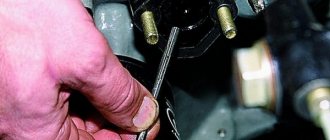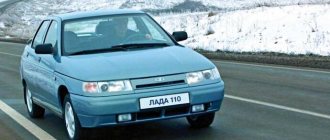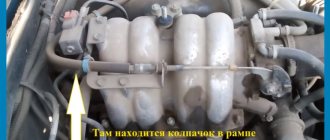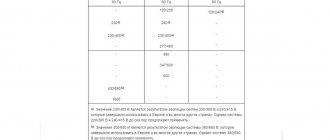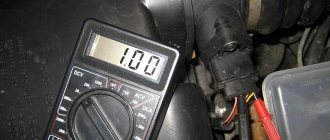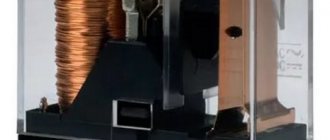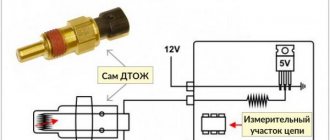Modern cars are equipped with a variety of electronics to control engine operation. They are equipped with different sensors. One of them is the so-called DBP - an absolute air pressure sensor in the intake manifold. As the name suggests, the sensor measures the difference in air pressure between a vacuum and an air-filled environment. For this purpose, the pressure sensor contains a vacuum chamber and a sensor.
The readings from the absolute pressure sensor on the intake manifold are used to optimize the air-fuel mixture entering the engine combustion chamber. How does this happen? Data from the intake manifold pressure sensor helps calculate the volume of incoming air for the combustible mixture, and based on this data, the injection nozzles are controlled.
How to check DBP
This article will talk about how to check the DBP (absolute pressure sensor) and the health of its circuits.
I will also post a video test at the end of the article. The absolute pressure sensor is the main sensor in the engine management system.
All processes in the engine depend on the mass of air entering the combustion chambers. That is why the only engine control lever in the driver’s hands (or rather feet) is the accelerator pedal.
What does the driver’s right foot do? Right! To supply air to the engine. That is, with the gas pedal we simply regulate the air supply. That's all.
At this stage, the human influence on the operation of the engine ends and everything passes into the “hands” of the engine control system. And the primary task of this system is to calculate the mass of air that we launched into the intake manifold. All subsequent actions taken by the ECU to control the engine depend on this calculation.
It is for these purposes that the absolute pressure sensor in the intake manifold is used. It measures the pressure in the manifold and the “brains” use this data to calculate the mass of air passing through the intake manifold into the engine.
But since it is the mass of air that is important, and not the volume, a temperature sensor of the air entering the cylinders must be installed in conjunction with the DBP. This is necessary because warm and cold air have different densities, and, as is known, the mass of a body or gas depends on density.
But we looked at the air temperature sensor in another article, and in this one we will focus exclusively on the absolute pressure sensor.
This is how everything is described in literature and manuals. But my opinion looks a little different. It is not intended to calculate air mass (this is calculated by software), but to determine the load on the engine. I will write about this below.
From all of the above, we can conclude that DBP is a mega important sensor in the engine control system and sometimes requires diagnostics, like all other sensors.
Let's look at the pros and cons of an injection system based on mass flow sensor and on the basis of DBP and DTV:
Disadvantages of a system with a mass air flow sensor:
- high cost of the sensor itself - reaction time to changes in air flow is much higher than for DBP, simply put, the brake sensor - almost completely unsuitable for engines with excess pressure due to the small upper measurement range - unstable mixture composition if the mass air flow sensor is moved close to the air pressure sensor , catches pulsations at the inlet
Advantages of a system with a mass air flow sensor:
— direct measurement of air flow, as a result it is difficult to ruin the engine, the mixture will most likely go richer than lean.
Advantages of a system with DBP and DTV:
- smoother idle on camshafts with an evil phase, we will consider the evil phase to be 290 and higher - the cost of a system of DBP and DTV sensors is three times cheaper - hello, sharp response to the gas pedal, the engine runs more elastic, very fast air calculation
- there are no large measuring elements in the intake system, and there is no mass air flow sensor mesh which serves to smooth the flow and which cannot be removed, as a result the engine produces a little more power - suitable for supercharged engines
— allows you to significantly increase the chances of installing a more optimal intake line; usually there should be a fairly small distance from the filter to the DS, which is difficult or even impossible to implement with a mass air flow sensor, and this is a loss of efficiency at low engine speeds
Cons of DBP+DTV:
- a complete reconfiguration of the control system will be required, with the departure from the factory software - direct hands and a clear head are urgently needed to install it - you need to figure out how to set up the car, or find a smart tuner, if you need to set it up for Pasha, there is a group in the contacts.
Source
How to check DBP yourself
To be completely honest, it is worth noting that the sensor has a mega reliable design and very rarely fails. But, unfortunately, I cannot say such flattering words about his wiring. At least on the Chevrolet Lacetti.
I don’t know where and from whom the idea came up to wire such an important sensor in this way. The fact is that two of the two sensor power wires have pins in their path, which over time can drain quite a bit of blood from the poor car owner.
Therefore, when checking DBP, it is necessary to pay more attention to the wiring and not to the sensor itself.
How can you check DBP?
There are many testing methods, but we only need the simplest ones and without special equipment. Right? I think yes!
Therefore, there are only two options left:
- using computer diagnostics
- using a multimeter
Connection options for Arduino
Connecting the BMP180 sensor to Arduino. To connect you will need the BMP180 sensor itself, the Arduino UNO board, and connecting wires. The connection diagram is shown in the figure below.
The ground from the Arduino needs to be connected to the ground on the sensor, the voltage is 3.3 V, SDA is to pin A4, SCL is to pin A5. Pins A4 and A5 are selected based on their support for the I2C interface. The sensor itself operates on a voltage of 3.3 V, and the Arduino operates on 5 V, so a voltage stabilizer is installed on the module with the sensor.
Connecting BMP 280 to Arduino. The pinout and top view of the board are shown in the figure.
The pressure sensor module itself looks like this:
To connect to Arduino, you need to connect the outputs as follows: connect ground to Arduino and on the sensor, VCC - to 3.3V, SCL / SCK - to analog pin A5, SDA / SDI - to A4.
Connecting the BME280 sensor. The location of the contacts and pinout of the BME280 sensor is the same as that of the BMP280.
Since the sensor can operate via I2C and SPI, the connection can be implemented using two methods.
When connecting via I2C, you need to connect the SDA and SCL pins.
When connecting via SPI, you need to connect SCL from the module and SCK (13th pin on Arduino), SDO from the module to pin 12 of Arduino, SDA to pin 11, CSB (CS) to any digital pin, in this case to pin 10 on Arduino . In both cases, the voltage is connected to 3.3V on the Arduino.
How to check DBP using computer diagnostics
Everything you need for independent computer diagnostics is presented in simple language in the Chevrolet Diagnostics section.
In this way, you can quite simply assess the condition of the sensor.
Here you need to pay attention to two parameters - barometric pressure and absolute pressure in the manifold. Why two?
Because DBP is not really DBP
It measures not only the absolute pressure in the manifold, but also the ambient pressure. This is necessary in order for the engine to operate adequately not only in ordinary terrain, but also, for example, in mountainous terrain, where atmospheric pressure decreases as altitude increases. And different atmospheric pressure has different effects on processes in the engine, so the ECU must know this same pressure in order to apply certain corrections in engine control. More details about the work of DBP and what processes affect its readings can be found here
We will touch on this parameter a little lower. Now let’s start checking DBP using diagnostic charts.
When the engine is not running, then the pressure in the manifold is equal to atmospheric pressure, which can be seen in the graphs
As we see, this is so. So at this stage everything is fine.
With the engine running and idling, the pressure in the intake manifold drops by almost 70% and should be 30-35 kPa
When you press the accelerator pedal, the pressure in the manifold inevitably increases. Therefore, DBP should signal this. If the damper is open to a large angle with the current load on the engine (acceleration, driving uphill, etc.), then the pressure in the manifold will increase to atmospheric
If the DBP, when pressing the accelerator pedal under load , practically does not change its readings or does so with a large delay, then you should definitely understand the reason for this behavior, since this is a malfunction. For example, if the engine speed under heavy load has already risen to more than 2000 rpm, but the DBP does not respond to this, showing low pressure in the manifold, then this is not normal.
Note: When you press the gas pedal at idle and there is no load on the engine (air conditioning, heated rear window, etc.), low readings (22-25 kPa) are adequate. That's how it should be! I'll try to explain it in simple language. When you press the gas pedal, a sharp surge in readings occurs - this is the DBP working to change the conditions in the manifold and the engine has not yet had time to spin up and “take in” the air that entered through the slightly open damper.
Then the engine gained speed and it is easy for it to rotate and develop further speed, since nothing interferes with it (no load). The higher its speed, the more it sucks air into itself, creating even greater vacuum in the manifold, since we do not open the damper completely, but only to maintain the speed we want.
Under load (we start, accelerate, turn on the air conditioner), the operating conditions change. It is no longer so easy for the engine to develop speed and it does so more slowly and does not have time to suck in the incoming air. Because of this, the pressure in the manifold increases. We press the pedal even harder, demanding revolutions from the engine, it strains and develops revolutions slowly. As a result, we open the damper completely and the pressure in the manifold becomes almost atmospheric. That is, the higher the pressure in the manifold, the heavier the engine. This is nothing more than an “engine load sensor”, and not a “sensor for calculating air mass”, which I wrote about above.
Here's another interesting point. Only here the DBP shows a very high barometric pressure, which in his opinion is as much as 112 kPa. Although a maximum pressure of 108 kPa was recorded on our planet!
It is clear that the sensor is showing false readings and this needs to be corrected. The first step in case of such symptoms is to check and clean the mass from the ECU to the engine. In the Chevrolet Lacetti it is located under the starter. Here it is written about the Lacetti masses.
How to check an absolute pressure sensor with a multimeter
Checking DBP with a multimeter consists of several parts:
- checking the resistance of the wires from the control unit to the sensor
- checking the voltage on the sensor
- checking the voltage at the sensor in idle mode
First of all, you need to ring three wires from the DBP to the ECU. In 80% of cases, it is at this stage that the problem is discovered.
I didn’t take photos of the process, since I filmed everything on video, in which you can see it all.
I will simply describe the essence of the test.
Disconnect the negative terminal of the battery.
Next, you need to remove the block from the DBP and from the ECU. You can see how to do this in the video, or in the article Lacetti's problem of three masses
There are three wires from the ECU block to the DBP block that we need to check:
- 1 - mass (A)
- 2 - signal (B)
- 3 - power supply +5 V (C)
To check the DBP wiring, you need to set the ohmmeter to resistance measurement mode up to 200 Ohms and connect the probes in this order:
- to the 1st contact of the DBP block and to the 13th contact of the ECU block
- to the 2nd contact of the DBP block and to the 75th contact of the ECU block
- to the 3rd contact of DBP and to the 50th contact of the ECU block
In all these cases, the resistance should be minimal, and when pulling the wiring harness with your hands, the resistance should not change. If the reading values change, this means that there is an unreliable contact in the wiring and it is necessary to cut the wiring harness and find the problem area.
If at this stage the problem is not detected, then it is necessary to measure the voltage at the sensor.
To do this, we connect back the ECU block, the DBP block and the battery terminal.
We turn on the ignition, but do not start the engine.
We switch the multimeter to DC voltage measurement mode up to 20 V.
We connect the negative probe of the multimeter to the first contact of the absolute pressure sensor, and the positive probe to the third contact. If the probes do not fit into the connector, then you can use ordinary paper clips, insert them into the connector, and connect our probes to them.
The voltmeter should show a voltage of approximately 4.9 V. This means that power is being supplied to the sensor.
Then we connect the “positive” probe to the second contact, and leave the second probe in the first.
The voltage should be approximately 3.5 - 4 V if you are not in the mountains
Let's start the engine. On a warm engine at idle and with consumers turned off (air conditioning, heated rear window, headlights, etc.), the voltage should be approximately 1 V. When the throttle is opened, the voltage should increase and then decrease.
It is also necessary to check the tube from the sensor to the intake manifold for clogging and condensation. And check the fitting on the manifold for clogging with oil from the crankcase ventilation system
If the tube is blown out, the wiring is intact, power is supplied, but the DBP does not work correctly, or does not work at all, then most likely it is time for it to go to the landfill.
The sensor's response can be checked in another way. To do this, turn on the ignition, connect a voltmeter to the first and second contacts of the DBP, disconnect the sensor tube from the manifold and connect a medical syringe to it. When the syringe piston moves, the sensor should respond to this, which can be seen by the changing voltage on the multimeter.
These are all the simple manipulations that will help you check the DBP and identify problems in its wiring.
Here is a video on how to check DBP
Previous Vehicle Diagnostic Parameter - Throttle Position
Return to the main section Car diagnostics
Where can I buy
Spare parts and other products for the car are easily available for purchase at auto stores in your city. But there is another option that has recently received significant improvements. You no longer need to wait a long time for a parcel from China: the AliExpress online store now offers the opportunity to ship from transshipment warehouses located in various countries. For example, when ordering, you can specify the “Delivery from the Russian Federation” option.
Follow the links and choose:
| Intake air pressure sensor 4Bar for Renault, Peugeot, KIA, Hyundai, Citroen | GKFLY car jump starter, external battery | Car charger, 2 USB ports, 5 V, 3.1 A |
| EANOP HUD car display, windshield projector | Baseus car humidifier | Car automatic parking sensors with 4 sensors |
Absolute pressure sensor
Some car enthusiasts do not fully understand what an absolute pressure sensor is in the engine control system. Therefore, I decided to present this post in order to express my opinion on this topic and debunk some myths and misconceptions that we constantly encounter to one degree or another.
I have already written a post and made a video about checking the manifold absolute pressure sensor using a conventional multimeter. But not everyone fully understood the essence of how this sensor works. Therefore, in the comments you constantly have to answer the same questions, which takes a lot of time.
In addition, in the search engine results about the absolute pressure sensor, one “water” is given, which everyone copies and pastes from each other, which further misleads novice drivers of cars with an engine management system built on a MAP sensor.
Visualization
Now let’s try to display pressure readings in the SFMonitor program, and see how the pressure changes when the sensor moves to a height of 2 meters.
static const byte PACKET_SIZE = 1; static const byte VALUE_SIZE = 2; static const boolean SEPARATE_VALUES = true; #include #include #include SFE_BMP180 pressure; SerialFlow rd(&Serial); double P0 = 0; void setup(){ rd.setPacketFormat(VALUE_SIZE, PACKET_SIZE, SEPARATE_VALUES); rd.begin(9600); pressure.begin(); P0 = getPressure(); } void loop(){ double P; P = getPressure(); rd.setPacketValue(100+int((P - P0)*100)); rd.sendPacket(); delay(100); } double getPressure(){ … }
As a result of the program, we obtain a pressure graph in Pascals:
Manifold absolute pressure sensor
To begin with, it is worth noting that in most cases, calling this sensor an absolute pressure sensor is not entirely correct, since its task is not only to measure the absolute pressure in the manifold, but also the atmospheric (barometric) pressure outside the manifold. Therefore, it can just as well be called a barometric pressure sensor.
Why is this necessary?
The fact is that in different places on our planet the atmospheric pressure is not the same. And in the same place the pressure changes over time.
And with different pressures, the density of the air also changes, which leads to a change in the mass of air by the same volume. And these are completely different engine operating conditions, and the engine control unit must take this situation into account in order to correctly control the same engine.
When the ignition is turned on, the ECU first evaluates the barometric pressure. Since the engine is not running yet, the pressure in the manifold is equal to atmospheric pressure. It is this point that allows you to avoid installing an additional pressure sensor that would measure barometric pressure.
I repeat once again - the value of barometric pressure is a very important measurement for the normal operation of the engine control system!
That is why the vehicle operating manuals indicate a requirement - when driving in mountainous areas or, conversely, when you are driving from a hill, say, towards the sea, you must periodically stop the engine so that the ECU determines new barometric pressure values.
But which driver will stop the engine just because it says so in the owner's manual? And who actually reads them?
Therefore, the ECU contains algorithms for rechecking barometric pressure, which work without stopping the engine. This usually occurs when the engine is under heavy load and the throttle is near maximum open.
Let's look at the graphs below. Before the gas pedal is pressed sharply and completely, the barometric pressure is 98 kPa
Next, we sharply press the gas pedal all the way and the control unit takes re-measurements of barometric pressure. It is now 97 kPa
Why did I describe all this?
And to bring you to the first misconception about this sensor.
When checking an absolute pressure sensor, most people only pay attention to the pressure in the manifold! This is understandable - it’s an absolute pressure sensor, which means it’s necessary to check the absolute pressure. The logic, in principle, is clear, but having already had some experience, I can state, based on my personal statistics, that in the overwhelming majority of cases of malfunctions of the absolute pressure sensor, the problems arise precisely in the incorrect measurement of barometric pressure. Although the absolute pressure at this moment does not raise questions.
I have a lot of such problematic graphs and I won’t post them all, of course. But I’ll show you a couple as an example. Here the barometric pressure is 112 kPa. I also saw readings of 115 kPa. Although the maximum pressure on the planet was officially registered, in my opinion, 108 kPa.
Therefore, the sensor is clearly and blatantly lying
Here's another example. A car is driving on a normal road and the barometric pressure reading is 98 kPa.
But after a couple of seconds, the pressure drops to 84 kPa
The pressure dropped by 14 kPa! Could this happen in reality?
Of course not. The sensor is clearly giving incorrect readings. Although there are no complaints about the absolute pressure in the manifold.
In general, the first conclusion is that the absolute pressure sensor serves not only to measure absolute pressure, but also to measure barometric pressure. Moreover, quite often problems manifest themselves precisely in barometric pressure measurements, which leads to problems in operation and engine starting.
The second conclusion is that the absolute pressure sensor measures the pressure in the manifold! If in the last graph the absolute pressure is 28 kPa, then this is a pressure of 28 kPa, but not a vacuum, and certainly not a vacuum, as you can often find this description on the Internet. This is pressure!
Well, now let’s move smoothly to the third and most important conclusion. What is an absolute pressure sensor used for and what does its readings depend on?
Absolute pressure sensor readings
The readings from the absolute pressure sensor are used to calculate air flow and to determine the load on the engine.
But if the calculation of air flow is carried out indirectly according to the data of the absolute pressure sensor, then the load on the engine is a direct dependence of the pressure in the manifold.
The lower the manifold pressure, the less load on the engine. And vice versa - the higher the pressure in the manifold, the greater the load on the engine. This is exactly how the engine control unit understands it.
Therefore, manifold pressure is the most important signal to the ECU. Even the position of the remote control is not such an important signal for the ECU as the pressure in the manifold.
And this is where misconceptions and misunderstandings begin for many.
Symptoms of Code P0108
Although the symptoms of code P0107/P0108/P0109 are almost the same for all cases, it should be noted that not all symptoms are always present. Additionally, the severity of some symptoms may vary depending on the vehicle, but for the most part, the most common symptoms include the following:
- CHECK ENGINE is on.
- Stored trouble codes, which may in some cases include faults for a specific vehicle make and model.
- Increased fuel consumption.
- Reduced engine power and performance.
- Hard start.
- Acceleration problems in most cases.
- Unpredictable engine shutdown.
- Rough idle.


